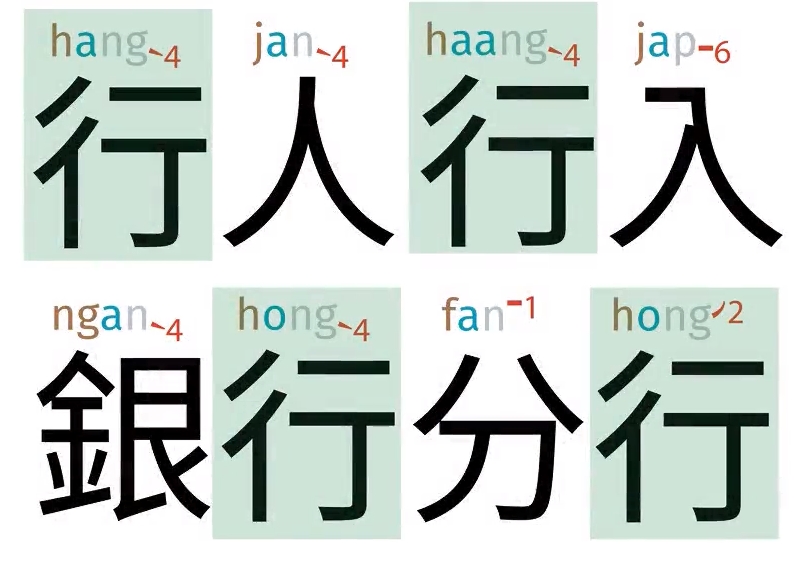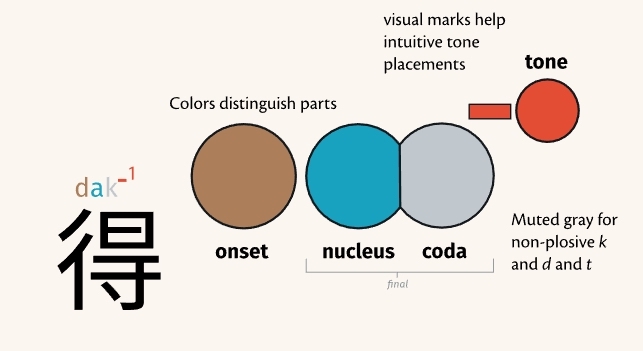"Romanisation 'gives clarity'"
« previous post | next post »
As we have pointed out countless times on Language Log, if one wishes to learn a Sinitic language, one can concentrate on the characters (writing system), one can rely exclusively on romanization or other phoneticization, or one can devise various means for combining the two approaches. Here is a clever, fun method for learning Cantonese that tackles the problem head on.
Hongkonger creates colourful Cantonese font to foster language learning
Jon Chui’s new font shows coloured, context-sensitive jyutping for Chinese text. He created it as his partner “had a hard time with the tones” when learning Cantonese.
Mandy Cheng, Hong Kong Free Press (5/16/23)
Jon Chui "has created a new Cantonese font, which combines over 8,000 characters with colourful, Romanised pronunciation guides in order to foster language learning and teaching."

Cantonese Font. Photo: Jon Chiu.
“Initially I just wanted to do this because my wife is Argentinian and I tried to teach her Cantonese,” said Jon Chui. “She had the hard time with the tones.”
…
Chui told HKFP that the biggest problem when learning Cantonese is mapping different pronunciations to characters: “It is difficult for people to think about how Cantonese has one character that maps to many sounds.”
Cantonese is a Chinese language with a complex series of tones – there are six lexical tones and three allotones in Hong Kong Cantonese.
To deal with the issue of tones changing in different contexts, Chiu set the most common pronunciation as the default tone for each character. When the character is followed by a specific character to form a special word, the pronunciation guide will automatically change.
The pronunciation is shown in Jyutping, a Cantonese romanisation system. The jyutping is coloured to distinguish different parts of the pronunciation including the onset, nucleus and coda.
There are visual markings to show tone placements, and the font also includes a Hong Kong oriented mini-dictionary feature, which translates English into Chinese as users are typing.
…
Romanisation ‘gives clarity’
“It’s really great to see more tools that support Jyutping romanisation,” Maggie Holmes, the co-founder of NGO Chinese as an Additional Language Hong Kong, told HKFP on Wednesday.
“Learners of Chinese as an additional language need romanisation because it gives us clarity about how to pronounce each character,” said Holmes, whose organisation supports students studying Chinese in Hong Kong.
However, she had some reservations about “plastering Jyutping indiscriminately above long chunks of Chinese text,” as it can be difficult to focus on the characters. Nevertheless, she added that using Jyutping is still vital when new vocabulary is being introduced.
I can't vouch for how successful and efficient Jon Chui's Canto Font is in producing Cantonese learners who are comparably competent in speech and writing of this Sinoglyphic language, but at least he has given the matter serious thought and come up with an ingenious system.
Selected readings
- "How to learn to read and write Chinese" (8/13/19)
- "How to learn Mandarin" (7/17/18)
- "How not to learn Chinese" (4/16/17)
- "How to learn Chinese and Japanese" (2/17/14)
[Thanks to Don Keyser]

AntC said,
May 20, 2023 @ 4:29 am
a hard time with the tones.
Yeah. I lived in HK for a year in 1990-91. English was the prestige language for International business, so nobody really wanted to speak Cantonese to me. Indeed everybody was desperately learning Putonghua, in anticipation of the PRC takeover.
All the 'Chinese' language learning materials I could find were for Mandarin, with just a few cute phrases for Cantonese. There was no reliable tone marking system. And all the special Cantonese-specific characters were just a nightmare. Outside of the business/tourist hotspots, even road names had no reliable/consistent romanisation; restaurant menus were hazardous — fortunately all the food was delicious, irrespective of how it was spelled — excepting sea slug and pigs trotters, but they weren't on the gweilo menus.
So good on Jon Chui. I'm quite a lot surprised it's worth learning Cantonese as opposed to Mandarin.
Taylor, Philip said,
May 20, 2023 @ 5:37 am
It came as a complete surprise to me to learn that the character 行 has (at least) four different pronunciations in Cantonese. Having learned what little Mandarin I know solely through oral/aural lessons and Pinyin (no hanzi, other than in passing), I would be interested to learn whether it and other characters are similarly overloaded when pronounced in Mandarin.
Victor Mair said,
May 20, 2023 @ 7:05 am
Many thanks to AntC and Philip Taylor for their excellent comments.
Later today (this evening) or tomorrow morning, I will make another post on this subject prompted by a note that Apollo Wu serendipitously and astonishingly sent to me BEFORE I made this post. Mind-boggling that he did so.
Jonathan Smith said,
May 20, 2023 @ 10:50 am
Compare the color coding and positioning/orientation used in the Hambaanglaang story videos, mentioned on LL before…
Re: not "'plastering Jyutping indiscriminately above long chunks of Chinese text' as it can be difficult to focus on the characters," learners of Cantonese etc. would au contraire be well advised not to so much look a single character for a couple years or so, but we've been there too many times…
Jonathan Smith said,
May 20, 2023 @ 10:53 am
sowith the above example, imagine learning the words 'walk', 'pedestrian', 'bank' and 'branch' in a normal way, only later noting (indifferently) the shared written elements… aaaaahhhhhh wouldn't that be nice :D
Neil Kubler said,
May 20, 2023 @ 3:13 pm
Interesting and creative, and it certainly is good that tones are being given the attention they require. But the idea of learning SPEAKING through WRITING (no matter how cleverly tones might be indicated in that writing system) still troubles me. It would be easier and more efficient to FIRST learn simple conversational Cantonese (from native speakers and audio recordings, with romanization available for reference but not as the focus) and THEN several months or years later learn the characters that correspond to the spoken words that have already been learned.
Rodger C said,
May 20, 2023 @ 3:19 pm
I've never heard of anyone eating sea slugs. Do you mean sea cucumbers? They're an entirely different biological family. I tried them once; rather like green, fish-flavored Jello.
Andreas Johansson said,
May 24, 2023 @ 6:28 am
Technically, sea slugs and sea cucumbers each make up several different families. They're classified in different phyla – more distant than, say, people and salps.
Rodger C said,
May 25, 2023 @ 12:33 pm
Yes, I should have said "phyla."
Chas Belov said,
June 3, 2023 @ 8:12 pm
Interesting. I can't speak to whether it would have helped me in my Cantonese studies. We used Yale romanization, which I found easy to use although, alas, computers don't handle tone marks on the m or n, necessary for syllabic m and n, very well.
I'm concerned with respect to online use that the colors chosen don't appear to meet the World Wide Web Consortium's WCAG 2.0 AA contrast requirements for accessibility, which would make it hard for people with low vision to make out the content. I rather imagine it would cause a problem in print as well.